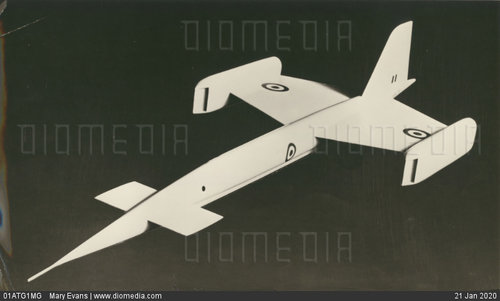Проект разведчика-бомбардировщика Handley-Page HP.100 (Великобритания)

www.dogswar.ru
The British project was developed by Handley-Page and it received the
HP.100 index. Among the options being developed, the most important priority was the variant with a delta wing and front-facing horizontal plumage, that is, the so-called "duck" scheme. According to the initial mission, the vehicle was to cruise at a speed of 2.5 M (2950 km/h) at an altitude of 19,120 meters.
The main structural materials are special heat-resistant steel and titanium. Aerodynamic heating of the surface of the aircraft at such speeds would be from 230 degrees Celsius to 270 degrees Celsius. The aircraft had to find widespread use of so-called layered structures. The chassis, control devices and pipelines were placed in the cooled compartments. The combat range was to be 4,000 miles, or about 7,400 kilometers.
The general design was to be completed in December 1956, the wind tunnel study was to be completed in July 1957, and the first scheduled flight was to take place in mid-1959. The series was supposed to be launched by the last quarter of 1964. Although the aircraft was originally intended to be used as a strategic reconnaissance aircraft, a requirement was added in 1957 from which the aircraft could be used as a bomber with weapons of free-range nuclear bombs or aeroballistic missiles. The wide track of the chassis allowed to place the combat load under the fuselage. The possibility of placing the rocket over the fuselage was also investigated. In the variant of the bomber with a payload on an external suspension weighing 5443 kg, the aircraft had a range of 8,800 km and a speed of 2.5M at an altitude of 19812 meters. The vehicle had an extremely thin wing with sharp front edges and developed slats, as well as the deflected nose part of the fuselage on take-off and landing, as it was later done on concord and Tu-144 aircraft, as well as an experienced Soviet strike aircraft T-4 Sukhoi.
According to the project, the machine was to be equipped with
twelve RB.121 engines, placed in six pieces, in three pairs, on the lower surface of the wing, on each side of the fuselage. The layout of the keel seating at the ends of the wing was investigated, but in the end it was rejected in favor of one large keel with a traditional location in the tail part.
The aircraft was to be fitted with a search-and-reconnaissance radar with two large antennas (15.24 m) placed on the side surface of the fuselage, as well as a pulse-doppler radar. The crew consisted of two pilots and two equipment operators. The normal take-off weight was about 93,000 kg, the load on the wing - 400.3 kg/m, the working ceiling - 18837-24384 m,
cruising speed - 1.76-2.5 M in different variants,
range - 7500 km without refueling and 11000 km with refueling in the air. The range of flight at ultra-low altitude scant to
3,890 km. In my opinion, the figures look too optimistic, but they are taken from British sources.
Span : 59.4ft, Length : 185ft, Wing area : 2,500ft2, Gross weight : 205,000lb, RB121 : 81,600lb each.
Log into Facebook to start sharing and connecting with your friends, family, and people you know.

www.facebook.com


 www.facebook.com
www.facebook.com



 www.britmodeller.com
www.britmodeller.com




www.quartoknows.com
